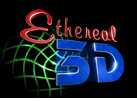

 |
 |
||||||
| |
|
|
|
|
|
|
|
Often displacement mapping is used in 3D applications to add effects to a surface or to simulate motion on a surface. Very typically, water is done this way using displacement mapping on a subdivided plane to add the waves and a some depth the the surface. There is another very powerful use for displacement mapping and that is in adding detail to an object. This tutorial shows how a displacemt map can add signicant detail to an otherwise very simple object.
First we just need a couple of simple objects to apply these techniques to. In this tutorial, I have setup just a simple pillar which I want to apply a ruged rock texture onto. The pillar is a sub-D surface so that it can be subdivided at render time yet created as a cylinder just bend up a bit to add a little more variation.
 |
Make sure your texture map wraps perfectly, check that your object is subdividable and save you new pillar object. |
| Create an object (rock pillar) for the displacement | Apply the rock texture you want to see |
Next we need to setup a simple scene to view the object and it is best to shine a light at your object from the side so you can get a better lighting effect once we start to modify the depth of the object's surface using displacement. You should have something like that shown below.
 |
This is the object now in a simple scene with a light from one side so the depth of the surface on the object is easier to see. |
| Color texture applied to object |
 |
We now need to add the specularity channel. This can done
easiest by just using the same texture as the color map but on the specularity
channel. This has been done here and works well because the surface of the rocks are the brightest areas in the texture anyway, and those are the areas we want to add some specularity to. |
| Added the specularity channel to the pillars |
 |
Next, we need to add a diffuse channel to darken the grout areas of the pillar. To do this, we will greyscale our rock color texture, increase its contrast and darken it somewhat. Apply this modified texture to the diffuse channel. |
| Added the diffuse channel to the pillars |
 |
Then, we apply the same diffuse texture to the bump channel to add
a bit of lighting depth |
| Added the bump channel to the pillars |
Finally, we now get to the displacement mapping. We want to have each of the rocks stand out from the pillar and displace the actual geometry of the object so that it looks far more detailed and ruged than the smooth textured surface shown above. Now, you need to apply your bump map to a displacement channel for your object. This is either done as a texture on the object itself or still within the materials for the surface. Often you can choose a normal displacement for the object itself or apply a textured displacement map for your object. This is what we will do next, but you also need to turn up the level of subdivision to ensure that enough detail is shown with your object.
Note: In Lightwave, you can add displacement to your object in
the Object Properties > Deform Tab > Add Displacement > Normal Displacement
This will then allow you to apply a texture to the displacement channel and
see the results in realtime within layout.
 |
Here we have applied the displacement map and increased the levels of subdivision on the object. This shows the object without the color map applied so you can really see the geometric detail. |
| Geometric displacement channel applied |
 |
And this is the final image with all the texture maps turned back on as well as the obvious displacement geometry. It adds a lot of extra detail to the object without having to model it and makes the lighting and shadows of the object much more realistic than standard bump mapping. Final image at 800x600 (114 Kb) |
| Final image rendered using displacement geometry |
Site Map
| Contact
| Products
| Services
| Portfolio
| Tutorials
| Resources
Copyright © 2009
Ethereal 3D. All rights reserved.
Email:
:: Phone : (403)
670-9921